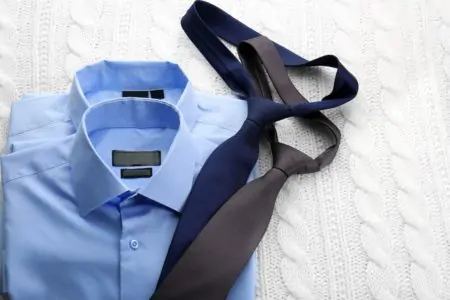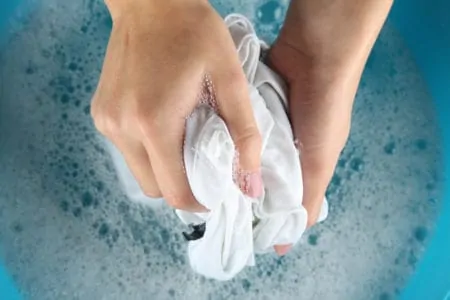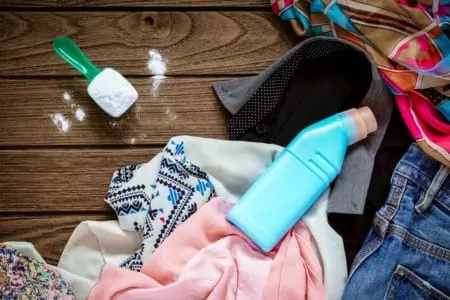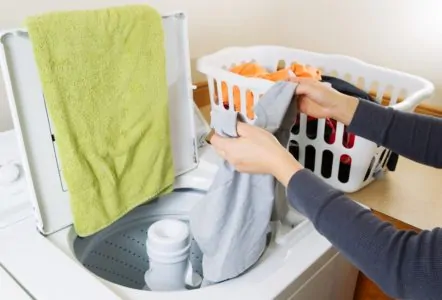You might be about to toss your dirty tie in the washing machine with the rest of your clothes, but before you do that — stop. There are very specific instructions when it comes to washing a tie.
My husband has a ton of different ties, all made of a variety of materials. So when it comes to washing them, we have to be careful so we don’t ruin the materials.
We’re going to share the best way to clean a tie, depending on the material. We’ll also share some tips for drying, storing, and ironing your ties. By the end, you’ll be prepared for any stain, odor, or dirt on your beloved ties.
Key Takeaways
- Hand wash linen, cotton, seersucker, knit, microfiber, and polyester ties with gentle detergent and water; hang to dry.
- Dry clean silk and wool ties, but avoid dry cleaning leather ties.
- Remove stains by blotting, using seltzer water, talcum powder, or stain remover products depending on the type of stain.
- Iron or steam ties based on their fabric type; store ties by hanging them up or rolling square-tipped knit ties in a drawer.
Can I Wash a Tie in the Washing Machine?
Most ties should not be washed in the machine. Check the care label of your tie to see the instructions. My husband has a bunch of ties, and only one of them says it can be machine washed. The rest are hand wash or dry clean only.
How to Clean a Tie
You may not think to wash your tie, but after a long day at work or a night of dancing at your friend’s wedding, ties are subject to dirt. They can get sweaty, smelly, and of course, you can spill food down them.
Still, ties are made of delicate materials and aren’t cheap. So it’s important to know how to clean a tie properly and safely.
Dry Cleaning
One option you have is dry cleaning. The care label will specify if a tie is “dry clean only.” This is normally the case for silk and wool. Be careful though, because some materials shouldn’t be dry cleaned at all, such as leather.
If your tie says “dry clean only,” this will help to preserve the glossy look and the finish of the tie. When you take it to the dry cleaners, make sure to ask them to hand-press the tie because the mechanical pressing methods can ruin the rounded edges of a tie. Especially on silk — the edges can break past the point of repair.
On another note, if you’re struggling to get out stains on other materials, call your local dry cleaners and ask if they can help. Again, make sure to ask them to hand-press the tie.
Did You Know
Hand Washing
Thankfully, there are some materials that don’t require a trip to the dry cleaners. This is normally the case for linen, cotton, seersucker, knit, microfiber, and polyester.
How to Hand Wash Ties
To get those hand-wash only ties super clean, follow these steps:
- Fill up a basin, bucket, or sink with cool or warm water. For seer-sucker and knit ties, only use cool water. For microfiber, only use warm water.
- Add a few drops of gentle laundry detergent. We recommend finding laundry detergent that suits your material type. If washing knit ties, use a detergent made for knitwear.
- Mix the water and detergent together.
- Add the ties to the solution and let them soak for 10 minutes.
- Gently agitate the ties together or use a soft-bristled brush to remove dirt and stains.
- Rinse well.
- Use a towel to press out the excess water.
- Hang the ties to air dry. Do not hang them over a radiator as this can cause shrinkage, cause colors to fade, or just cause overall damage to the tie.
How to Remove Stains from Ties
Stains on a tie can be a big source of panic, but if you act fast, there shouldn’t be any evidence that you ever spilled your wine or dropped a canapé down your tie.
- Blot the stain with a cloth or napkin as soon as possible. Do not rub the stain as this can embed it into the tie’s fibers.
- If it’s a water-soluble stain, use seltzer water or club soda to blot the stain.
- If it’s an oil-based or grease stain, apply talcum powder, foot powder, cornstarch, or baking soda to the tie to absorb the excess oil. In a pinch, you could even put a slice of white bread over the stain. Let the powder — or bread — sit for a few hours before brushing the stain with a cloth.
- For liquid spills, blot the area with a white paper towel or napkin. Colorful napkins can transfer dye to your tie. When possible, use a stain remover product to get rid of the stain. Follow the manufacturer’s instructions for how much to apply and for long to leave it on for.
- Rinse the area with water.
- Hand wash or take to the dry cleaners, depending on the fabric.
How to Iron and Store Ties
If your tie is looking a little wrinkly after being washed or stored improperly, you may be able to iron it depending on the fabric:
- Silk: It’s best to steam silk ties on a low setting. If you need to iron it, place the tie on a towel. Then put a slightly damp towel over the tie. Put the iron on the lowest setting and slowly move over the damp towel. Do not remove the towels until they have completely dried.
- Wool: Do not iron wool ties. Instead, use a clothes steamer at the lowest setting holding the steamer far from the tie. A word of caution though — only do this when absolutely necessary.
- Linen: When the linen tie is drying, gently press it to remove wrinkles. If in a pickle, use the steam setting on your iron to blast out the remaining wrinkles.
- Cotton: You can steam or iron cotton ties on a hot setting.
- Seer-sucker: Steam or iron seer-sucker ties on the lowest setting.
- Knit: Don’t use an iron on knit ties. If necessary, use a steamer on the lowest setting, holding the steamer at least six inches away from the tie.
- Microfiber: Steam or iron on a low setting.
- Polyester: It’s best to steam iron polyester ties. If ironing, use a low or medium setting.
- Leather: Don’t steam or iron leather ties.
The best way to store your ties is to hang them up immediately. This will prevent creases and wrinkles. You can simply drape them over a hanger or use a tie rack.
If you have square-tipped knit ties, you should roll these up loosely and store them in a drawer. This prevents them from stretching out and losing their shape.
Top Tip
The Best Tips for Maintaining Ties
When you buy a new tie, you’ll want it to last. Here are top tips for lengthening the life of your ties:
- Be careful when you’re wearing a tie. Eat and drink carefully to avoid spills. Put a napkin over your tie, in the collar or your shirt to protect your tie. You may even want to remove your tie while you eat.
- When traveling, roll your ties up and place them in individual baggies. You could also invest in a tie travel case. Don’t fold your ties.
- Make sure to check the care label to find out the material of your tie so you know how best to wash and dry it.
- Never put your ties in a tumble dryer. Always hang them to air dry.
- Remove stains immediately. The longer they sit, the more likely they are to set.
- Before air drying your ties, pat them gently with a towel to remove excess water. Never bunch or wring the ties to remove the water.
- Never use bleach to clean your ties, even if they’re white. This can cause damage.
- Always use a gentle detergent that’s suited for the tie’s material type.
- Always hang when storing, unless you have a square-tip knit tie. If you fold or roll your ties and put them in a drawer, this can easily lead to wrinkles.
- Don’t tie your tie too tightly as this can cause wear and tear. When you remove your tie, always undo the knot, don’t just pull it over your head.
FAQs
Tying It Up
Now that you know the best way to take care of your ties, they should last a long time.
You don’t need to wash your ties after every wear. But check for stains, dirt, and bad smells and wash them whenever you notice anything like this. Remember to always check the care label to see if it can be hand washed or requires dry cleaning.
Caring for your ties properly will extend the lifespan. Then you won’t have to fork out more money every time you are going to an event where a tie is required.











